Efficient and Reusable Iron Catalyst to Convert CO2 into Valuable Cyclic Carbonates
Abstract
:1. Introduction
2. Results and Discussion
3. Materials and Methods
4. Conclusions
Author Contributions
Funding
Conflicts of Interest
References
- Energy Technology Perspectives 2015, Mobilising Innovation to Accelerate Climate Action, International Energy Agency. Available online: https://www.iea.org/publications/freepublications/publication/ (accessed on 20 January 2021).
- Pera-Titus, M. Porous Inorganic Membranes for CO2 Capture: Present and Prospects. Chem. Rev. 2014, 114, 1413–1492. [Google Scholar] [CrossRef] [PubMed]
- Anderson, T.S.; Kozak, C.M. Ring-opening polymerization of epoxides and ring-opening copolymerization of CO2 with epoxides by a zinc amino-bis(phenolate) catalyst. Eur. Polym. J. 2019, 120, 109237. [Google Scholar] [CrossRef]
- Patil, N.G.; Boopathi, S.K.; Alagi, P.; Hadjichristidis, N.; Gnanou, Y.; Feng, X. Carboxylate Salts as Ideal Initiators for the Metal-Free Copolymerization of CO2 with Epoxides: Synthesis of Well-Defined Polycarbonates Diols and Polyols. Macromolecules 2019, 52, 2431–2438. [Google Scholar] [CrossRef] [Green Version]
- Kozak, C.M.; Ambrose, K.; Anderson, T.S. Copolymerization of carbon dioxide and epoxides by metal coordination complexes. Coord. Chem. Rev. 2018, 376, 565–587. [Google Scholar] [CrossRef]
- Andrea, K.A.; Kerton, F.M. Iron-catalyzed reactions of CO2 and epoxides to yield cyclic and polycarbonates. Polym. J. 2021, 53, 29–46. [Google Scholar] [CrossRef]
- Lopes, E.J.C.; Ribeiro, A.P.C.; Martins, L.M.D.R.S. New trends in the conversion of CO2 to cyclic carbonates. Catalysts 2020, 10, 479. [Google Scholar] [CrossRef]
- Montoya, C.A.; Gómez, C.F.; Paninho, A.B.; Nunes, A.V.M.; Mahmudov, K.T.; Najdanovic-Visak, V.; Martins, L.M.D.R.S.; Silva, M.F.C.G.D.; da Ponte, M.N.; Pombeiro, A.J.L. Cyclic carbonate synthesis from CO2 and epoxides using zinc(II) complexes of arylhydrazones of β-diketones. J. Catal. 2016, 335, 135–140. [Google Scholar] [CrossRef] [Green Version]
- Della Monica, F.; Vummaleti, S.V.C.; Buonerba, A.; De Nisi, A.; Monari, M.; Milione, S.; Grassi, A.; Cavallo, L.; Capacchione, C. Coupling of Carbon Dioxide with Epoxides Efficiently Catalyzed by Thioether-Triphenolate Bimetallic Iron(III) Complexes: Catalyst Structure–Reactivity Relationship and Mechanistic DFT Study. Adv. Synth. Catal. 2016, 358, 3231–3243. [Google Scholar] [CrossRef]
- Elkurtehi, A.I.; Kerton, F.M. Coupling Reactions of Carbon Dioxide with Epoxides Catalyzed by Vanadium Aminophenolate Complexes. ChemSusChem 2017, 22, 1249–1254. [Google Scholar] [CrossRef] [PubMed]
- Ribeiro, A.P.C.; Martins, L.M.D.R.S.; Pombeiro, A.J.L. Carbon dioxide-to-methanol single-pot conversion using a C-scorpionate iron(II) catalyst. Green Chem. 2017, 19, 4801–4962. [Google Scholar] [CrossRef]
- Alhashmialameer, D.; Collins, J.; Hattenhauer, K.; Kerton, F.M. Iron amino-bis(phenolate) complexes for the formation of organic carbonates from CO2 and oxiranes. Catal. Sci. Technol. 2016, 6, 5364–5373. [Google Scholar] [CrossRef] [Green Version]
- Martín, C.; Fiorani, G.; Kleij, A.W. Recent Advances in the Catalytic Preparation of Cyclic Organic Carbonates. ACS Catal. 2015, 5, 1353–1370. [Google Scholar] [CrossRef]
- Qiu, J.; Zhao, Y.; Li, Z.; Wang, H.; Fan, M.; Wang, J. Efficient Ionic-Liquid-Promoted Chemical Fixation of CO2 into α-Alkylidene Cyclic Carbonates. ChemSusChem 2017, 10, 1120–1127. [Google Scholar] [CrossRef]
- Jiang, X.; Gou, F.; Chen, F.; Jing, H. Cycloaddition of epoxides and CO2 catalyzed by bisimidazole-functionalized porphyrin cobalt(iii) complexes. Green Chem 2016, 18, 3567–3576. [Google Scholar] [CrossRef]
- Hu, J.; Ma, J.; Zhu, Q.; Zhang, Z.; Wu, C.; Han, B. Transformation of Atmospheric CO2 Catalyzed by Protic Ionic Liquids: Efficient Synthesis of 2-Oxazolidinones. Angew. Chem Int. Ed. 2015, 54, 5399–5403. [Google Scholar] [CrossRef]
- Goodrich, P.; Gunaratne, H.Q.N.; Jacquemin, J.; Jin, L.; Lei, Y.; Seddon, K.R. Sustainable Cyclic Carbonate Production, Utilizing Carbon Dioxide and Azolate Ionic Liquids. ACS Sust. Chem. Eng. 2017, 5, 5635–5641. [Google Scholar] [CrossRef]
- Comerford, J.W.; Ingram, I.D.V.; North, M.; Wu, X. Sustainable metal-based catalysts for the synthesis of cyclic carbonates containing five-membered rings. Green Chem. 2015, 17, 1966–1987. [Google Scholar] [CrossRef]
- Sopeña, S.; Martin, E.; Escudero-Adán, E.C.; Kleij, A.W. Pushing the Limits with Squaramide-Based Organocatalysts in Cyclic Carbonate Synthesis. ACS Catal. 2017, 7, 3532–3539. [Google Scholar] [CrossRef]
- Zhou, H.; Wang, G.-X.; Zhang, W.-Z.; Lu, X.-B. CO2 Adducts of Phosphorus Ylides: Highly Active Organocatalysts for Carbon Dioxide Transformation. ACS Catal. 2015, 5, 6773–6779. [Google Scholar] [CrossRef]
- Arayachukiat, S.; Kongtes, C.; Barthel, A.; Vummaleti, S.V.C.; Poater, A.; Wannakao, S.; Cavallo, L.; D’Elia, V. Ascorbic Acid as a Bifunctional Hydrogen Bond Donor for the Synthesis of Cyclic Carbonates from CO2 under Ambient Conditions. ACS Sustain. Chem. Eng. 2017, 5, 6392–6397. [Google Scholar] [CrossRef] [Green Version]
- Kumatabara, Y.; Okada, M.; Shirakawa, S. Triethylamine Hydroiodide as a Simple Yet Effective Bifunctional Catalyst for CO2 Fixation Reactions with Epoxides under Mild Conditions. ACS Sustain. Chem. Eng. 2017, 5, 7295–7301. [Google Scholar] [CrossRef]
- Whiteoak, C.J.; Martin, E.; Belmonte, M.M.; Benet-Buchholz, J.; Kleij, A.W. An Efficient Iron Catalyst for the Synthesis of Five- and Six-Membered Organic Carbonates under Mild Conditions. Adv. Synth. Catal. 2012, 354, 469–476. [Google Scholar] [CrossRef]
- Sutradhar, M.; Martins, L.M.D.R.S.; Guedes da Silva, M.F.C.; Pombeiro, A.J.L. Oxido vanadium complexes with tridentate aroylhydrazone as catalyst precursors for solvent-free microwave-assisted oxidation of alcohols. Appl. Cat. A Gen. 2015, 493, 50–57. [Google Scholar] [CrossRef]
- Martins, L.M.D.R.S. C-scorpionate complexes: Ever young catalytic tools, Coord. Chem. Rev. 2019, 396, 89–102. [Google Scholar] [CrossRef]
- Martins, L.M.D.R.S.; Pombeiro, A.J.L. Water-soluble C-scorpionate complexes: Catalytic and biological applications. Eur. J. Inorg. Chem. 2016, 2016, 2236–2252. [Google Scholar] [CrossRef]
- Martins, L.M.D.R.S.; Pombeiro, A.J.L. Tris(pyrazol-1yl)methane metal complexes for catalytic mild oxidative functionalizations of alkanes, alkenes and ketones. Coord. Chem. Rev. 2014, 265, 74–88. [Google Scholar] [CrossRef]
- Silva, A.; Luís, D.; Santos, S.; Silva, J.; Mendo, A.S.; Coito, L.; Silva, T.F.S.; Guedes da Silva, M.F.C.; Martins, L.M.D.R.S.; Pombeiro, A.J.L.; et al. Biological characterization of the antiproliferetive potential of Co(II) and Sn(IV) coordination compounds in human cancer cell lines: Role of comparative proteomics. Drug Metabol. Drug Interact. 2013, 28, 167–176. [Google Scholar] [CrossRef]
- Silva, T.F.S.; Martins, L.M.D.R.S.; Guedes da Silva, M.F.; Kuznetsov, M.L.; Fernandes, A.R.; Silva, A.; Santos, S.; Pan, C.-J.; Lee, J.-F.; Hwang, B.-J.; et al. Cobalt complexes with pyrazole ligands as catalysts for the peroxidative oxidation of cyclohexane. XAS studies and biological applications. Chem. Asian J. 2014, 9, 1132–1143. [Google Scholar] [CrossRef]
- Fernandes, A.R.; Jesus, J.; Martins, P.; Figueiredo, S.; Rosa, D.; Martins, L.M.D.R.S.; Corvo, M.L.; Carvalheiro, M.C.; Costa, P.M.; Baptista, P.V. Multifunctional gold-nanoparticles: A nanovectorization tool for the targeted delivery of novel chemotherapeutic agents. J. Control. Release 2017, 245, 52–61. [Google Scholar] [CrossRef]
- Martins, L.M.D.R.S.; Alegria, E.C.B.A.; Pombeiro, A.J.L. Synthesis and Biological Applications of Tris(pyrazol-1-yl)-Methane and -Borate Metal Complexes; Smolenski, P., Gawryszewska, P., Eds.; Ligands: Synthesis, Characterization and Role in Biotechnology; Nova Science Publishers Inc.: New York, NY, USA, 2014; Chapter 4; pp. 117–140. ISBN 978-1-63117-143-7. [Google Scholar]
- Ribeiro, A.P.C.; Martins, L.M.D.R.S.; Hazra, S.; Pombeiro, A.J.L. Catalytic Oxidation of Cyclohexane with Hydrogen Peroxide and a Tetracopper(II) Complex in an Ionic Liquid. C. R. Chim. 2015, 18, 758–765. [Google Scholar] [CrossRef]
- Ribeiro, A.P.C.; Martins, L.M.D.R.S.; Kuznetsov, M.L.; Pombeiro, A.J.L. Tuning cyclohexane oxidation: Combination of microwave irradiation and ionic liquid with the C-scorpionate [FeCl2(Tpm)] catalyst. Organometallics 2017, 36, 192–198. [Google Scholar] [CrossRef]
- Silva, T.F.S.; Alegria, E.C.B.A.; Martins, L.M.D.R.S.; Pombeiro, A.J.L. Scorpionate Vanadium, Iron and Copper Complexes as Selective Catalysts for the Peroxidative Oxidation of Cyclohexane under Mild Conditions. Adv. Synth. Cat. 2008, 350, 706–716. [Google Scholar] [CrossRef]
- Li, C.Y.; Su, Y.C.; Lin, C.H.; Huang, H.Y.; Tsai, C.Y.; Lee, T.Y.; Ko, B.T. Synthesis and characterization of trimetallic cobalt, zinc and nickel complexes containing amine-bis(benzotriazole phenolate) ligands: Efficient catalysts for coupling of carbon dioxide with epoxides. Dalton Trans. 2017, 461, 5399–15406. [Google Scholar] [CrossRef]
- Wang, J.-Q.; Dong, K.; Cheng, W.-G.; Sun, J.; Zhang, S.-J. Insights into quaternary ammonium salts-catalyzed fixation carbon dioxide with epoxides. Catal. Sci. Technol. 2012, 2, 1480–1484. [Google Scholar] [CrossRef]
- Fuchs, M.A.; Zevaco, T.A.; Ember, E.; Walter, O.; Held, I.; Dinjus, E. Synthesis of cyclic carbonates from epoxides and carbon dioxide catalyzed by an easy-to-handle ionic iron(iii) complex. Dalton Trans. 2013, 42, 5322–5329. [Google Scholar] [CrossRef]
- Kiatkittipong, K.; Shukri, M.A.A.M.; Kiatkittipong, W.; Lim, J.W.; Show, P.L.; Lam, M.K.; Assabumrungrat, S. Green Pathway in Utilizing CO2 via Cycloaddition Reaction with Epoxide—A Mini Review. Processes 2020, 8, 548. [Google Scholar] [CrossRef]
- Kopylovich, M.N.; Mahmudov, K.T.; Silva, M.F.C.G.; Martins, L.M.D.R.S.; Kuznetsov, M.L.; Silva, T.F.S.; Fraústo da Silva, J.J.R.; Pombeiro, A.J.L. Trends in properties of para-substituted 3-(phenylhydrazo)pentane-2,4-diones. J. Phys. Org. Chem. 2011, 24, 764–773. [Google Scholar] [CrossRef]
- Jiang, S.; Hua, Y.; Wang, Y.; Wang, X. Viscosity of Typical Room-Temperature Ionic Liquids: A Critical Review. J. Phys. Chem. Ref. Data 2019, 48, 033101. [Google Scholar] [CrossRef]
- Plechkova, N.V.; Seddon, K.R. Applications of ionic liquids in the chemical industry. Chem. Soc. Rev. 2008, 37, 123–150. [Google Scholar] [CrossRef] [PubMed]
- Muldoon, M.J.; Aki, S.N.V.K.; Anderson, J.L.; Dixon, J.K.; Brennecke, J.F. Improving carbon dioxide solubility in ionic liquids. J. Phys. Chem. B 2007, 111, 9001–9009. [Google Scholar] [CrossRef]
- Park, D.W.; Mun, N.Y.; Kim, K.H.; Kim, I.; Park, S.W. Addition of carbon dioxide to allyl glycidyl ether using ionic liquids catalysts. Catal. Today 2006, 115, 130–133. [Google Scholar] [CrossRef]
- Wang, L.; Zhang, G.; Kodama, K.; Hirose, T. An efficient metal- and solvent-free organocatalytic system for chemical fixation of CO2 into cyclic carbonates under mild conditions. Green Chem. 2016, 18, 1229–1233. [Google Scholar] [CrossRef]
- Jin, L.; Jing, H.; Chang, T.; Bu, X.; Wang, L.; Liu, Z. Metal porphyrin/phenyltrimethylammonium tribromide: High efficient catalysts for coupling reaction of CO2 and epoxides. J. Mol. Catal. A Chem. 2007, 261, 262–266. [Google Scholar] [CrossRef]
- Driscoll, O.J.; Hafford-Tear, C.H.; McKeown, P.; Stewart, J.A.; KociokKöhn, G.; Mahon, M.F.; Jones, M.D. Highly efficient palladium-catalysed carbon dioxide hydrosilylation employing PMP ligand. Dalton Trans. 2019, 48, 15049–51058. [Google Scholar] [CrossRef] [Green Version]
- Sun, F.; Zhang, D.J. Density Functional Theory Study on the Cycloaddition of Carbon Dioxide with Propylene Oxide Catalyzed by Alkylmethylimidazolium Chlorine Ionic Liquids. Phys. Chem. A 2007, 111, 8036–8043. [Google Scholar] [CrossRef] [PubMed]
- Reger, D.L.; Grattan, T.C.; Brown, K.J.; Little, C.A.; Lamba, J.J.; Rheingold, A.L.; Sommer, R.D. Syntheses of tris (pyrazolyl) methane ligands and {[tris (pyrazolyl) methane] Mn (CO) 3} SO3CF3 complexes: Comparison of ligand donor properties. J. Organomet. Chem. 2000, 607, 120–128. [Google Scholar] [CrossRef]
- Alegria, E.C.B.A.; Martins, L.M.D.R.S.; Guedes da Silva, M.F.C.; Pombeiro, A.J.L. Syntheses and Properties of Re(III) Complexes Derived from Hydrotris(1-pyrazolyl)methanes. Molecular Structure of [ReCl2(HCpz3)(PPh3)][BF4]. J. Organomet. Chem. 2005, 690, 1947–1958. [Google Scholar] [CrossRef]
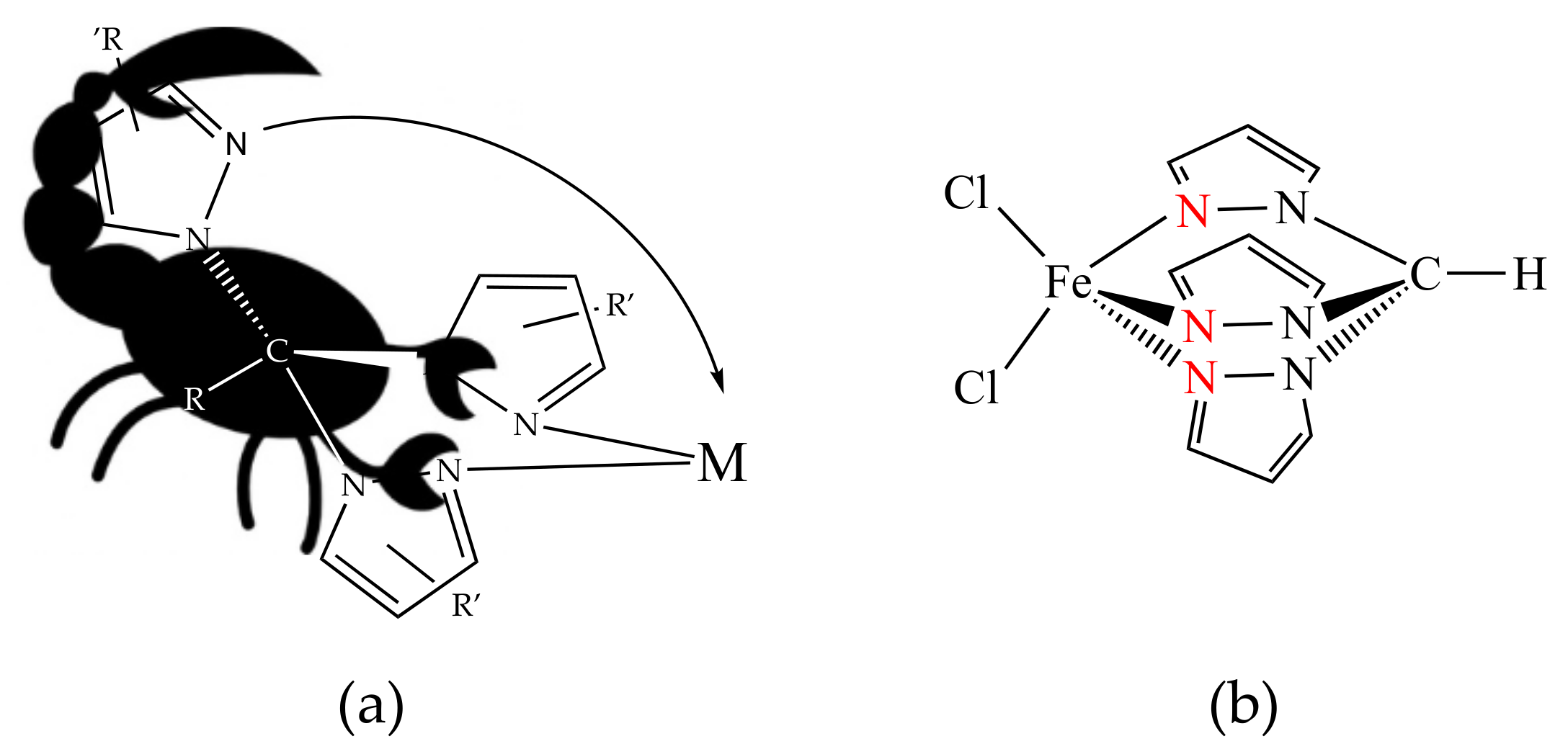

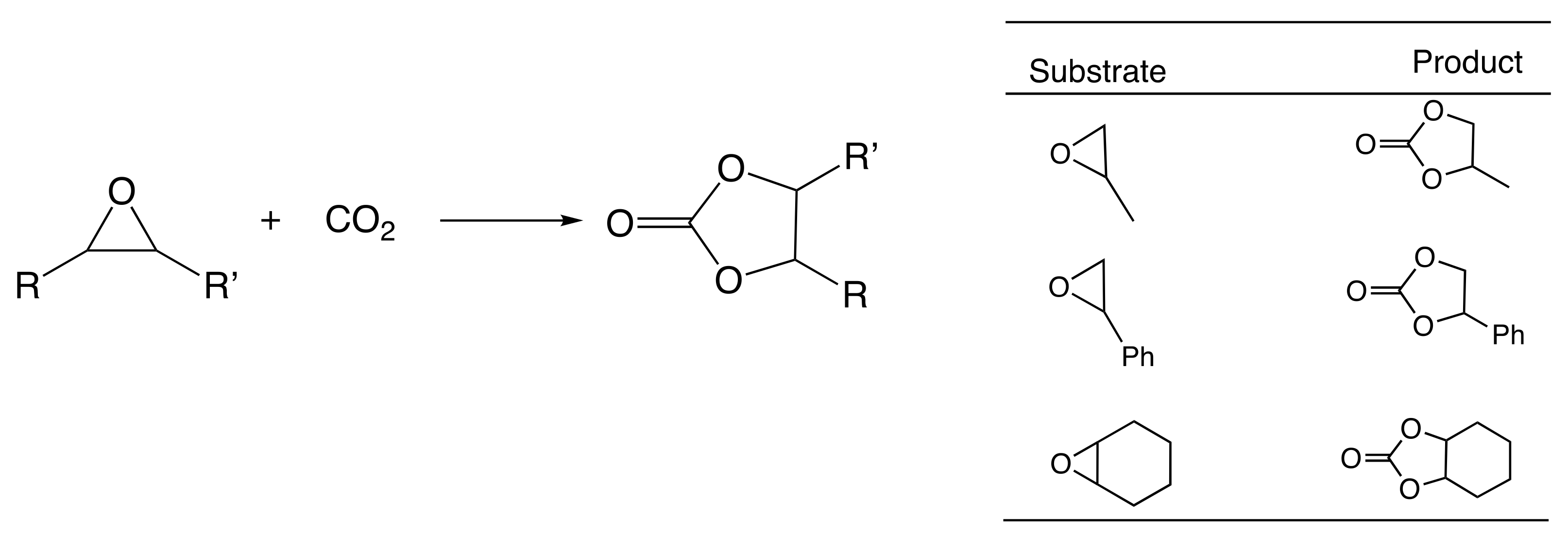
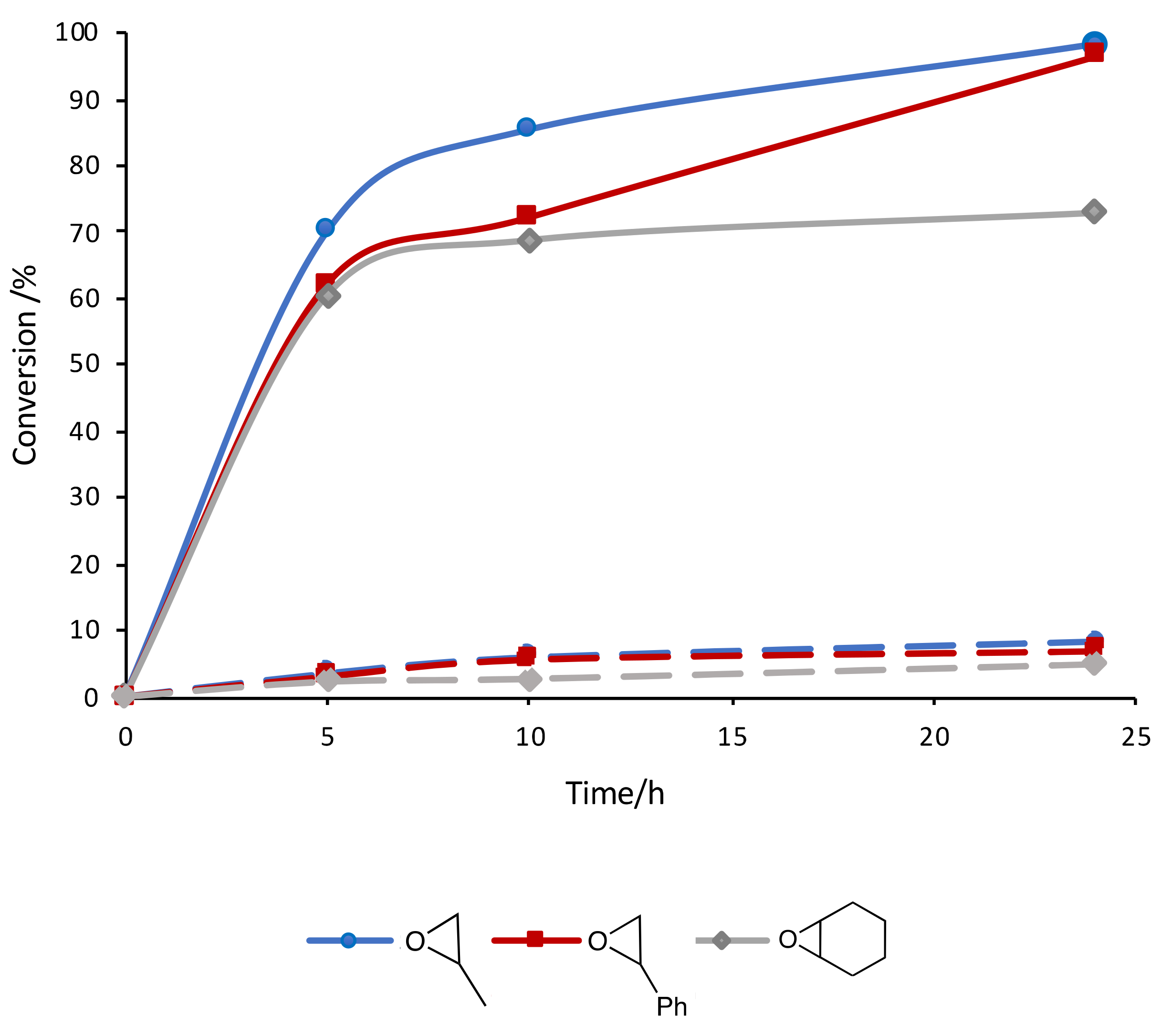


| Entry | Ionic Liquid | Epoxide | Product | Yield/% b | TON c | TOF/h−1 d |
|---|---|---|---|---|---|---|
| 1 | [emim][N(CN)2] | 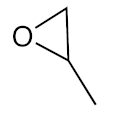 |  | 96.7 | 193 | 8 |
| 2 | [bmim][N(CN)2] | 98.3 | 197 | 8 | ||
| 3 | [emim]Cl | 81.6 | 163 | 7 | ||
| 4 | [bmim]Cl | 90.0 | 180 | 8 | ||
| 5 | [emim][NTf2] | 72.8 | 146 | 6 | ||
| 6 | [bmim][NTf2] | 78.7 | 157 | 7 | ||
| 7 | [emim][N(CN)2] |  | 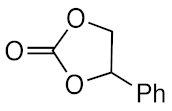 | 92.3 | 185 | 8 |
| 8 | [bmim][N(CN)2] | 96.4 | 193 | 8 | ||
| 9 | [emim]Cl | 77.4 | 155 | 6 | ||
| 10 | [bmim]Cl | 88.7 | 177 | 7 | ||
| 11 | [emim][NTf2] | 61.9 | 124 | 5 | ||
| 12 | [bmim][NTf2] | 72.6 | 145 | 6 | ||
| 13 | [emim][N(CN)2] |  |  | 69.3 | 139 | 6 |
| 14 | [bmim][N(CN)2] | 72.7 | 145 | 6 | ||
| 15 | [emim]Cl | 60.7 | 121 | 5 | ||
| 16 | [bmim]Cl | 69.3 | 139 | 6 | ||
| 17 | [emim][NTf2] | 40.7 | 81 | 3 | ||
| 18 | [bmim][NTf2] | 60.9 | 122 | 5 |
| Entry | Ionic Liquid | Styrene Carbonate Yield/% b |
|---|---|---|
| 1 | [emim][N(CN)2] | 0.3 |
| 2 | [bmim][N(CN)2] | 4.9 |
| 3 | [emim][Cl] | 0.5 |
| 4 | [bmim][Cl] | 1.6 |
| 5 | [emim][NTf2] | 0.1 |
| 6 | [bmim][NTf2] | 0.3 |
| Entry | Epoxide | Product | Yield/% b |
|---|---|---|---|
| 1 |  |  | 6.5 |
| 2 |  |  | 6.1 |
| 3 |  |  | 5.3 |
| Entry | Catalytic System | Epoxide | Carbonate Yield/% | Reference |
|---|---|---|---|---|
| 1 | 1-alkyl-3-methylimidazolium chloride | allyl glycidyl ether | 81 | [43] |
| 2 | ionic liquid/2,6-pyridinedimethanol/TBAB | epichlorohydrin | 67 | [44] |
| 3 | porphyrin iron complex | propylene oxide | 10 | [45] |
| 4 | iron(III)–acetate complexes/TBAC | cyclohexene oxide | up to 66 | [46] |
Publisher’s Note: MDPI stays neutral with regard to jurisdictional claims in published maps and institutional affiliations. |
© 2021 by the authors. Licensee MDPI, Basel, Switzerland. This article is an open access article distributed under the terms and conditions of the Creative Commons Attribution (CC BY) license (http://creativecommons.org/licenses/by/4.0/).
Share and Cite
Ribeiro, A.P.C.; Goodrich, P.; Martins, L.M.D.R.S. Efficient and Reusable Iron Catalyst to Convert CO2 into Valuable Cyclic Carbonates. Molecules 2021, 26, 1089. https://doi.org/10.3390/molecules26041089
Ribeiro APC, Goodrich P, Martins LMDRS. Efficient and Reusable Iron Catalyst to Convert CO2 into Valuable Cyclic Carbonates. Molecules. 2021; 26(4):1089. https://doi.org/10.3390/molecules26041089
Chicago/Turabian StyleRibeiro, Ana P. C., Peter Goodrich, and Luísa M. D. R. S. Martins. 2021. "Efficient and Reusable Iron Catalyst to Convert CO2 into Valuable Cyclic Carbonates" Molecules 26, no. 4: 1089. https://doi.org/10.3390/molecules26041089
APA StyleRibeiro, A. P. C., Goodrich, P., & Martins, L. M. D. R. S. (2021). Efficient and Reusable Iron Catalyst to Convert CO2 into Valuable Cyclic Carbonates. Molecules, 26(4), 1089. https://doi.org/10.3390/molecules26041089








